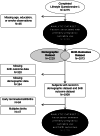Association between maternal cannabis use and birth outcomes: an observational study
- PMID: 33308186
- PMCID: PMC7731469
- DOI: 10.1186/s12884-020-03371-3
Association between maternal cannabis use and birth outcomes: an observational study
Abstract
Background: As cannabis consumption is increasing globally, including among pregnant women, there is a critical need to understand the effects of cannabis on fetal development and birth outcomes. We had two objectives: to determine 1) the factors associated with self-reported cannabis use in the pre/early-pregnancy period, and 2) whether cannabis use is associated with low birth weight, preterm birth, or small size for gestational age (GA) infants.
Methods: Maternal questionnaire and birth outcome data was gathered from 2229 women and 1778 singleton infants in the Ontario Birth Study, a hospital-based prospective cohort study (2013-2019). Women self-reported cannabis use within 3 months of learning their pregnancy status. Multivariable linear and logistic regression was conducted to 1) identify factors associated with cannabis use, and 2) determine the associations between cannabis use with the selected birth outcomes.
Results: Cannabis use increased in the cohort over time. Women who reported cannabis use (N = 216) were more likely to be younger and more likely to use alcohol, tobacco, and prescription pain medication, although most did not. These women had infants born at lower average birth weights and had 2.0 times the odds of being small for GA (95% confidence interval: 1.3, 3.3) after multivariable adjustment for socioeconomic factors and other substance use.
Conclusion: Our results suggest that women who use cannabis around the time of conception have higher odds of having infants that are small for gestational age. Targeted clinical messaging may be most applicable to women actively trying to conceive.
Keywords: Birth weight; Canada; Cannabis; Epidemiology; Marijuana; Pregnancy; Small for gestational age; Women.
Conflict of interest statement
The authors of this paper have nothing to disclose.
Figures
References
-
- Rotermann M, Macdonald R. Analysis of trends in the prevalence of cannabis use in Canada, 1985 to 2015. Health Rep [Internet]. 2018;(82):10–20. - PubMed
Publication types
MeSH terms
Grants and funding
LinkOut - more resources
Full Text Sources
Medical
Research Materials



